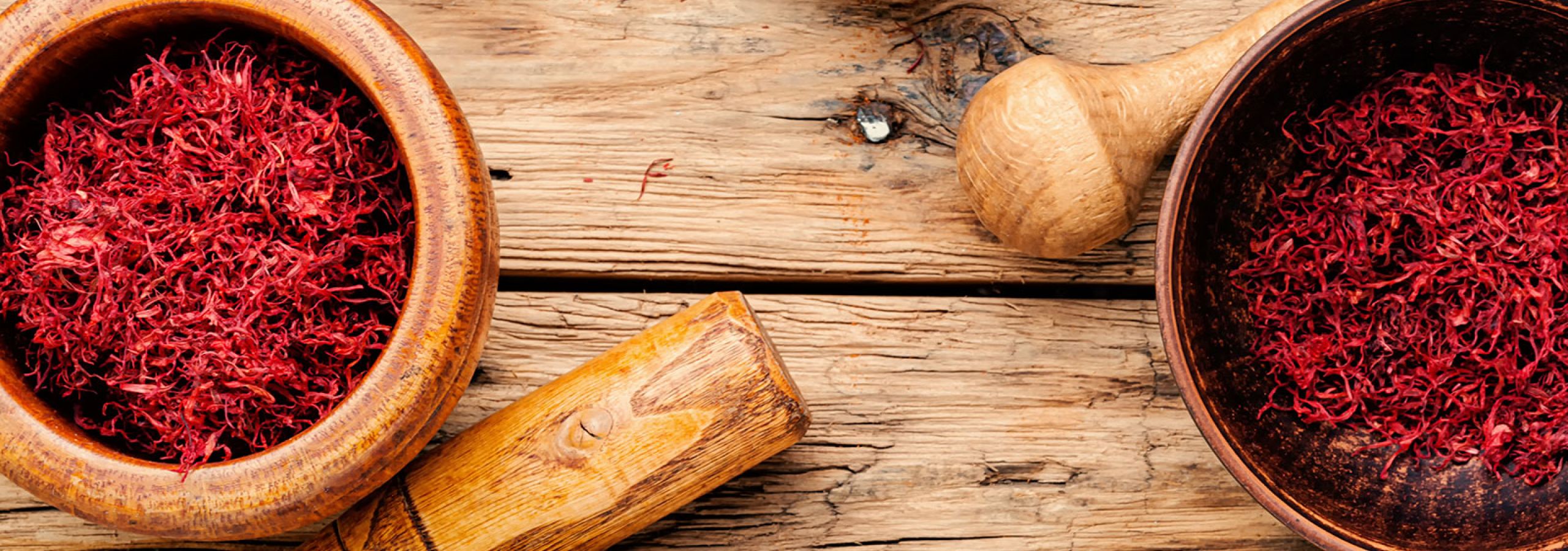
Saffron: nourishment and medicine of kings
Saffron is an oriental spice which derives from the stigma (the part of the flower where pollination takes place) of the Crocus sativus flower.
We can easily identify saffron by its mild bitter taste, its hay-like aroma and its yellow-gold hue. This attributes make saffron a very appreciated element in international gastronomy. The clearest example would be the Valencian paella, although there’s also the French Bouillabaisse soup and the Lussekatt, or Swedish Christmas buns. Although it is known it gives liquors like Chartreuse, Izarra and Strega their color and taste, not many realize this spice is used to treat numerous illnesses.
It originated in the middle-east, but it was initially cultivated in Greece; on the Crete frescos, which were painted around thirty centuries ago, one can see images of young people and monkeys collecting saffron. The wealthy Greeks and Romans dyed their celebration attires (nuptial clothing specially) with saffron, spread it around banquet halls and even stuffed it inside pillows. This was due to the aroma of saffron being associated to sensuality. The spice is also linked to powerful figures of the time. It’s said Alexander the Great used it dissolved in hot water to heal battle wounds and that Cleopatra poured one quarter of a cup of it in her bath in order to rejuvenate her skin and give it a golden hue. Also, Rome was sprinkled with saffron before Nero entered the city.
This relationship with wealth and power is not surprising considering saffron is the most expensive spice of all and it’s nicknamed “red gold”. The dry stigmas and tips of the styles must be picked up by hand early in the morning, when the flowers have barely opened and then are carefully dried over a small fire. 250 thousand flowers are need to produce a kilo of pure saffron, which sells for about six thousand dollars.
Its high price has resulted its adulteration or imitation since ancient times. In the first case, the fibers were kept in a humid room so they would absorb water and thus were heavier when weighed. In the second case, stigmas were imitated with horse meat fiber, onion skin or colored plaster.
It’s believed its name comes from the Arabic word “az-za’fran”, which means yellow, but it’s also said it comes from the Persian word “zaferan”, which means gold stigmas. It conserves its original name in most languages, with variations like “saffron” (English), “safran” (French) and zafora (Greek). Although it’s called “kesara” in Hindi and “kumkumam” in Sanskrit.
In its likely place of origin, Persia, it was believed to have a narcotic and aphrodisiac quality. It was also used as a skin cleanser and as sunscreen, especially when dissolved in water in an Indian sandalwood bowl. Due to its yellow color being considered a valuable offering to the gods, it was also used to produce rugs and funerary objects. When diagnosing somebody with melancholy, Persian doctors would order saffron to be placed in the patient’s bed and quarters, while also prescribing it as an infusion.
It arrived in India around 500 B.C. and since then, the saffron hailing from the Kashmir region has been considered the best, not only by the Ayurveda, but by traditional Chinese medicine as well.
In Ayurveda, saffron has a lot of therapeutic applications. Since it’s a flower; a reproductive organ itself, it’s mainly used in the ailment of problems in the reproductive system. Although it has an aphrodisiac effect on both sexes, especially if dissolved in milk, it’s considered particularly helpful to women, since it regulates the menstrual cycle, alleviates dysmenorrhea (difficult and painful menstruation) and P.M.S. It helps with fertility since it rejuvenates the female reproductive system. To treat cases of dysmenorrhea, amenorrhea (absence of menstruation) and menopause derived alterations, it’s recommended to take an infusion of 5 or 6 stigmas of saffron twice a day.
It’s a digestive and a mild appetite stimulant. It also reduces vomiting, treats diarrhea, is carminative and alleviates hemorrhoids.
The respiratory system also enjoys the benefits of saffron. It stops hemoptysis (the expectoration of blood due to a lung lesion) and it alleviates respiratory congestion.
It’s used to treat circulatory problems, arteriosclerosis and hemorrhages. It revitalizes blood with a stimulant, rejuvenating action, which is why it’s recommended to be consumed as a decoction: one gram of saffron per cup of milk. In case of anemia, it’s best to dissolve one gram in warm milk with clarified butter.
The benefits of saffron on the skin are highly praised. R. Svoboda writes in his book “Ayurveda, millenary medicine of India”: “It’s used in lotions to embellish the skin and have better cutis, either humans’ or the temple deities’. The ancient texts pay tribute to saffron as the supreme cosmetic for ladies’ breasts”.
Lastly, saffron is excellent nourishment for the brain. It promotes positive emotions and purifies the mind. Prepared as a decoction mixed with milk, it mitigates anger and calms anxiety. In incense form, it calms down the mind, alleviates stress and anger as well.
After realizing the relationship of saffron with power, wealth, sexual potency, rejuvenation and spirituality, it comes as no surprise that in India is well known that Krishna –divine incarnation, King of Dvarka and lover of over sixteen thousand women- would paint a tilak (a mark) of saffron on his forehead daily.



